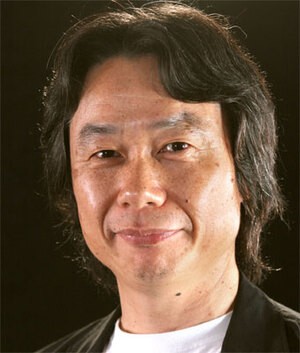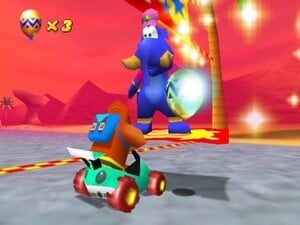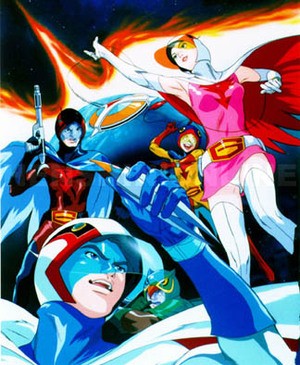
Back in the late ‘90s being an N64 owner was a testing experience. Having to listen to your Playstation-owning chums constantly droning on about Lara Croft and Solid Snake was enough to put any Nintendo devotee in a bad mood, but the general lack of quality software towards the end of the console’s lifespan was especially galling.
Bearing this in mind, it’s relatively easy to see why Rare is held in such high esteem with veterans of the N64 era; thanks to a string of stunning releases including Diddy Kong Racing, Perfect Dark, GoldenEye 007 and Blast Corps, the company found itself in a position of regard usually reserved for The Big N itself. Another game which cemented Rare’s relationship with its fans was Jet Force Gemini, arguably the company’s most innovative and inventive piece of software from that period.
An epic third-person sci-fi adventure, Jet Force Gemini saw the player assume control of a plucky team of futuristic freedom fighters – consisting of humanoid siblings Juno and Vela, cyber-pooch Lupus and Floyd the robot - as they attempt to release the galaxy from the vice-like grip of the evil Mizar.

Work began on the title in 1997 and while Rare pooled some of its key talent to work on the game, Lead Programmer Paul Mountain was relatively new to the company. “I joined Rare as a Software Engineering graduate in 1996 and worked on Diddy Kong Racing,” he reveals. “After Diddy Kong Racing’s completion in 1997 I moved to a new prototype project as the Lead Engineer; this was to become Jet Force Gemini.”
Falling somewhere in-between Rare’s cute and cuddly platforming titles and its more mature first person shooters, Jet Force Gemini’s inspirations were manifold. “It’s fair to say that many games from the team’s collective past influenced Jet Force Gemini, from ‘80s arcade classics right up to the most recent titles of the day,” recalls Mountain. “The free-roaming nature of Super Mario 64 influenced the scale and the openness of some of the backgrounds and settings. In equal measure the behaviour of the bad guys was a mixture of arcade space shooter formations and Quake-style ‘attack and cover’ mechanics. Super Metroid was also an influence on some areas of the game, such as the collecting and upgrading of weapons. I suppose, in short, we were inspired by all the good stuff we’d played and enjoyed playing.” It wasn’t just in terms of gameplay that the title borrowed from other sources, either. “Visually, it tried to pull from all over the place,” admits Lead Artist Lee Musgrave. “There are elements of Star Wars in there, Aliens, Dune, Battle of the Planets, even Stargate - it was a real mix of everything and anything 'space' related.”

Despite Rare’s close affiliation with Nintendo, the creative process was free from unwanted interference. “Nintendo took regular looks at the game during development and we listened to any feedback that they gave us, but it was essentially a Rare developed title,” explains Mountain. Outside pressure did result in one major change, though – the game’s protagonists originally sported an overly cute visual style, but this was altered at Nintendo’s behest. “I remember us showing Shigeru Miyamoto an early build,” says Musgrave. “After some particularly candid feedback on the characters, we made changes.”
However, it wasn’t just Miyamoto’s suggestions that instigated such aesthetic alterations, as Musgrave is quick to point out. “The art team grew in confidence and ability throughout the creation of Jet Force Gemini and started to push things harder technology wise. There were elements that were re-done just because we had learned how to do them better.”
Although the N64 had been available for a couple of years developers were still getting to grips with its innovative analogue controller and the Jet Force Gemini team was certainly no exception. “The overriding aim was to create a control system that was both fun and as easy to pick up and play as possible while retaining the variety of gameplay that we wanted,” explains Mountain. “Although much of this was completed in the first half of development we continued to play-test and tweak throughout the project.”

Just as it had enabled Super Mario 64 to shine, the N64 pad became intrinsic to the Jet Force Gemini experience. “The analogue controller was essential to us to get the game playing how we wanted. A digital system could not have given the same level of control and targeting finesse,” asserts Mountain. Jet Force Gemini’s control scheme is a two-part affair; walking around was very much like your typical 3D platformer, but entering a combat situation triggers a switch to a first person viewpoint. This unique system has since been replicated in games such as Resident Evil 4 and Gears of War.
“The idea behind the system was to retain a character-based game - hence the frequent use of a third person view where you see the character you are playing as - but to bring in some of the tightness and accuracy of a first person shooter,” reveals Mountain. “After many attempts to automate the change of view and targeting mode based on the context of the action we settled on a manual system with the targeting camera fixed behind the character’s head, as we felt this delivered the best gameplay experience.” The decision was a success. “The solution we ended with is a beautiful thing,” says Musgrave with a smile. “It feels very old-school to me; difficult, unforgiving, but ultimately precise."
Update: You can now read the second part of this exciting feature here.
This feature originally appeared in its entirety in Imagine Publishing’s Retro Gamer magazine, and is reproduced here with kind permission.





Comments 17
I just got this game recently. It's awsome.
The N64 is still me favorite game console of all time I still have the same one I bought back in the day the thing is a tank, it has been threw so much and still just keep's on ticking. On top of that the controller was amazing it looked funny at first but once I used it I feel in love with it really fast. So many GREAT games Mario Kart,Goldeneye,Mario and the best collection of wrestling games any system has ever put out. I could go on and on but I will stop...
One of the few RARE games that I want on the VC. Oh well...
Also, RARE changed their logo! See?
Failure to mention Banjo-Kazooie makes me sad Anyway interesting to see Rare before their cross to the dark side so full of imagination and creativity. As for the new logo, yep its official, the Rare we knew is now dead!
Why don't you come back home RARE,
and make more Donkey Kong Games.
I really want a remake of Jet Force Gemini on Xbox Live Arcade!
Jet Force Gemini is such a great game.
One of the all time greats on the N64.
The slight collect-a-thon mania that plagues all Rareware titles of the time (fine collecting the ship parts, we get to go to new areas/old areas with different case members but all the tribals as well...) does it let down slightly but it was a game I greately enjoyed. As for the article, I always wondered the reason why the game was delayed while the case got modified (Juno and Vela used to look a lot younger) so I guess that explains it.
This was one of my favorite games. I find it interesting that my younger brother, who was born in the ps2 era, plays my old n64 more than his 360. And if he isn't playing Zelda he is playing a rare game. Moving to microsoft was the worst decision Rare ever made. They fit into the Nintendo niche so well.
Congrats, you are just covering my favorite all time Nintendo 64 game! Yes, I know Zelda is in that system, too! But you gotta trust me, I waited a long time until Jet Force Gemini was released over here, bought it day 1 and went home to truly appreciate just what the N64 could offer in the right hands. It's a shame RARE seems to have forgotten all about it...
i play this game once every year... or at least try to. this is a real treat.
"what is regarded by many as the N64's finest action title"
Well, for the first half or so, anyway. Then, the game expects you to collect all 200+ frakking Tribals in the game--while an asteroid is hurtling toward Earth, mind you. So at the point where the plot seemingly turns into a race against time, the game itself enters hardcore collectathon mode and grinds to a halt.
I've never finished the game because of that ridiculous design decision. Which is a pity, because I really did love the first part. Ah, Rare.
The game that introduced me to shooters... Such an excellent game! If only they could release this on VC...
I am planning on ordering this when I make my next retro purchases.
I didn't know Miyamoto had input on THIS game too! Man, Rare sure did change a lot to accomodate that guy back in the day. The more you look into it, the more you see how he had hands in Dinosaur Planet, Diddy Kong Racing, Banjo-Kazooie and of course DKC. No wonder Rare games nowadays feel a tad "off" (although Kameo is still pretty awesome...stupid looking, googly-eyed monsters notwithstanding).
best childhood game evar!
Tap here to load 17 comments
Leave A Comment
Hold on there, you need to login to post a comment...